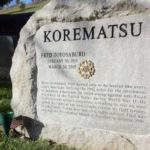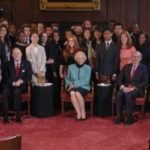On December 18, 1944, the U.S. Supreme Court handed down one of its most controversial decisions when it upheld the government’s decision to intern all persons of Japanese ancestry (both alien and nonalien) on the grounds of national security. Over two-thirds of the Japanese in America were citizens and the internment took away their constitutional rights. In this lesson, students evaluate the consequences of past events and decisions related to the Supreme Court case Korematsu v. United States (1944). They consider the challenges involved when trying to balance civil liberties and national security during threatening times and reflect on the lessons learned about civil liberties from the justices in the Korematsu case.
Provide for the General Welfare – Interstate Highway and Defense Act
In the Constitution, Congress is charged with providing for the general welfare of the country’s
citizens. Historically, this has meant improving transportation, promoting agriculture
and industry, protecting health and the environment and seeking ways to solve social and
economic problems. In 1956, Congress passed the Federal-Aid Highway Act, popularly known as the National Interstate and Defense Highways Act, authorizing federal funding for the extension and
construction of a robust network of interstate highways. This project was one of the largest public
works in U.S. history establishing key transportation infrastructure that impacted lives of all
Americans — changing communities, access and economic possibilities and also providing key
routes for evacuating urban centers — a critical national defense issue in the Cold War era.
Analyzing primary source material, students discuss the origins and reasons for the National
Interstate and Defense Highways Act. Then, they work with historical and contemporary maps
as they consider the impact this important congressionally funded project. While intended for 8th
grade students, the lesson can be adapted for other grade levels.
Iroquois Council: Choosing Sides
In this simulation, elementary or middle school students convene as an Iroquois council in upstate New York, 1777. British agents are trying to convince Iroquois nations to take their side in the Revolutionary War.
Search and Seizure Cartoon Analysis
Spark a conversation about the balance between national security and Fourth Amendment rights with this quick cartoon of Lady Liberty.
Rights at Risk in Wartime
The terrorist attacks on Sept. 11, 2001, stunned the nation. As commander-in-chief, President George W. Bush responded quickly but soon all three branches of government would be embroiled in the struggle to balance national security with the protection of individual liberties amid a war on terror. This lesson plan is based on the Annenberg Classroom video “Habeas Corpus: The Guantanamo Cases.” The four cases are examples of how the Supreme Court, the president and Congress fought to balance national security and civil liberties during the war on terror. At the heart of each case was the constitutional right of habeas corpus, the right to have one’s detention or imprisonment reviewed in court.
You Can’t Say That: Right to Know vs. Security Risk

Explain to students that tensions between the press and the military have always existed, as the goals of each group are often in conflict. Reporters want information to flow freely, while the military guards national security interests. The debate over how to balance these competing interests continues today.
Korematsu and Civil Liberties

This documentary explores the landmark case Korematsu v. U.S. (1944) concerning the constitutionality of presidential executive order 9066 during World War II that gave the U.S. military the power to ban thousands of American citizens of Japanese ancestry from areas considered important to national security. A PDF lesson plan accompanies this video.
A Conversation on the Importance of the Japanese Internment Cases

Justices Stephen G. Breyer, Sandra Day O’Connor and Anthony M. Kennedy discuss two landmark cases, Korematsu v. U.S. and Hirabayashi v. U.S., in which the Supreme Court tried to strike a balance between individual rights and national security during wartime. The cases stem from President Franklin Roosevelt’s 1942 executive order that mandated the relocation of Japanese and Japanese Americans to internment camps. This video complements the documentary Korematsu and Civil Liberties.
Guide to the State Statues in the National Statuary Hall Collection
The National Statuary Hall Collection in the United States Capitol is composed of statues donated by individual states to honor persons notable in their history. The entire collection now consists of 100 statues contributed by 50 states. All 50 states have contributed two statues each. Thirty-five statues are displayed in National Statuary Hall while others have been placed in other parts of the Capitol including the Crypt, the Hall of Columns, and the Capitol Visitor Center.
Stars and Stripes Forever: Flag Facts for Flag Day
Students will learn what a symbol is and how this particular symbol—the American flag—is an important part of our everyday lives. Learning the history of the flag will help instill in students respect for our national symbol and help them learn appropriate etiquette regarding our flag. Students will learn that other symbols of our country, such as the president and certain holidays, like Flag Day, are important to us as well. Students can also contribute symbols from their familial, ethnic and national cultures to show the diversity of American society and its links to other parts of the world.